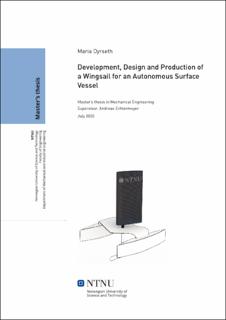| dc.contributor.advisor | Echtermeyer, Andreas | |
| dc.contributor.author | Dyrseth, Maria Brudeseth | |
| dc.date.accessioned | 2021-09-24T18:21:28Z | |
| dc.date.available | 2021-09-24T18:21:28Z | |
| dc.date.issued | 2020 | |
| dc.identifier | no.ntnu:inspera:60273394:20925855 | |
| dc.identifier.uri | https://hdl.handle.net/11250/2781743 | |
| dc.description.abstract | I løpet av de siste årene har det vært en økende interesse i å undersøke det marine økosystemets helse. Klimaendringer der økte havnivåer, en økende marin industri og shipping, plastikkavfall i havet og forurensing fra byer, er bare noen av feltene som har blitt fokusert på. I dag, blir undersøkelser på havet er hovesakelig gjort av forskningsbåter der personell må være tilstede, eller av instrumentelle utstyr slept av båter. De undersøkelsene som blir gjort av slike forskningsbåter er av høy kvalitet, men også med en høy kostnad med tanke på at den må være bemannet. I tillegg vil båtene som sleper instrumentelle utstyr, kun undersøke i de områdene der båter som regel kjører. Med en autonom, ubemannet overhavsbåt vil mye større områder kunne bli utforsket, som kan bidra til målet om å få samlet inn mer data relatert til havet vårt.
Denne masteroppgaven omhandler hele utviklingsprosessen, fra konsept og design, til produksjon av alle deler av et hul kompositt vingeseil for en autonom målingsbåt ved Norges teknisk-naturvitenskapelige universitet. Designprosessen var gjort ved å benytte strukturelle parameterstudier, sammen med komposittmodellering og numerisk fluiddynamikk for å lage et realistisk vindtrykk på vingeseilet. Bruk av simuleringsbasert kompositt-optimering i de tidlige designfasene, gjør at tiden for å oppnå et høyt ytende design er redusert. Resultatene fra det ferdige designet viste at maksimale vindtrykket ved 20 m/s som virker på vingeseilet, produserer en maksimal spenning i fiberretning på 21.37 MPa. De største spenningene på vingeseilet oppstod i masten og er på kun 1.66 % av styrken. Vektmålet var innfridd da alle delene på seilet veide totalt 19 kg med en maksimal deformasjon på 3.371 mm ved maksimal designet vindlast på 20 m/s.
Oppgaven beskriver også produksjonen av alle delene av vingeseilet der alt ble utført av forfatteren selv. Medium-Density Fiberboard ble brukt som støpeformmateriale for begge vingeskallene og de interne avstiverstagene. Karbonfiberdeler ble lagd med velkjente komposittproduksjonsmetoder som vikling, vakuuminfusjon og med pre-impregnert egnet til støp utenfor av autoklav. | |
| dc.description.abstract | During the last years, there has been a rising interest in exploring the health of the marine ecosystem. Climate changes due to rising waters, growing marine industry and shipping, plastic waste in the ocean, and pollution from cities, are only some of the topics that have been focused on. Today, the survey of the oceans is mostly done by scientific vessels with a crew or by vessels towing instrumental equipment. The scientific measurements done by the scientific vessels provide high-quality, but with a high cost. Vessels that tow equipment will only map the oceans in the areas where vessels usually travel. With Autonomous Unmanned Surface Vessels, much larger areas can be mapped, which can contribute to the goal of providing more data related to our oceans.
This thesis covers the whole development process, from concept and design to production of all parts of a hollow composites wingsail for an Autonomous Measurement Boat at the Norwegian University of Science and Technology. The design process was done utilizing a structural parametric study, together with composites modeling and Computational Fluid Dynamics (CFD) for creating a realistic wind pressure load. By using simulation-based composite layup optimization early in the design process, the time to achieve a high-performing design are reduced. The results from the final design showed that the wind pressure load at the maximum design wind velocity of 20 m/s acting on the wingsail, produced a maximum stress, in fiber direction S11 of 21.37 MPa. The stress occurred in the mast and is just 1.66 \% of the strength. The weight target was met with the wingsail weighing 19 kg while having a maximum deformation of 3.371 mm at the maximum design wind of 20 m/s.
The thesis also describes the manufacturing of all the parts of the wingsail, which was done by the author herself. Medium-Density Fiberboard was used as mould material, creating moulds for the outer shell and internal "ribs" of the wingsail. Carbon Fibre Reinforced Plastic (CFRP) parts were made utilizing common composites manufacturing methods such as filament winding, Vacuum Assisted Resin Infusion and out-of-autoclave pre-impergnated fibers. | |
| dc.language | | |
| dc.publisher | NTNU | |
| dc.title | Development, Design and Production of a Wingsail for an Autonomous Surface Vessel | |
| dc.type | Master thesis | |
